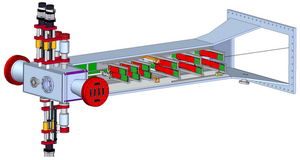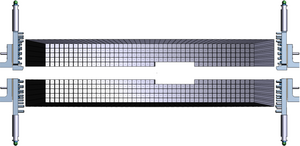Difference between revisions of "The HPS Run Wiki"
Jump to navigation
Jump to search
| Line 124: | Line 124: | ||
== Bring beam to FC (for the first time this must be done with beamline expert): == | == Bring beam to FC (for the first time this must be done with beamline expert): == | ||
# '''<font color=red> Important Note: Before bringing beams to FC, make sure that the SVT, Hodoscope, and ECal are off, SVT is fully retracted, the target is out. If this is a first time that beam goes to FC after machine settings have changed then the SVT protection collimator position relative to the beam trajectory is unknown and therefore HPS protection collimator must be retracted.</font>''' | # '''<font color=red> Important Note: Before bringing beams to FC, make sure that the SVT, Hodoscope, and ECal are off, SVT is fully retracted, the target is out. If this is a first time that beam goes to FC after machine settings have changed then the SVT protection collimator position relative to the beam trajectory is unknown and therefore HPS protection collimator must be retracted.</font>''' | ||
| − | # '''Ask for 10 nA beam. When the beam sent to FC, it should be clearly visible on the downstream viewer. The halo counter rates downstream of the HPS, | + | # '''Ask for 10 nA beam. When the beam sent to FC, it should be clearly visible on the downstream viewer. The halo counter rates downstream of the HPS, HPS-SC, and HPS-T should not be more than 10s of kHz. All upstream halo counters must be in the range of <100Hz.''' |
#'''First find the position of the collimator by performing the collimator wire scan. The current position of the wire for beam center is 4.41 (labeled on the GUI), if the measurement finds beam center at a different position use the expert GUI to set the 3.94 mm SVT collimator to the right position (current position is 6.212, which means that the distance between the wire and the center of the 3.94 mm hole is 1.802). After collimator is in place all beam studies should be done in these conditions with beam currents of 30 nA.''' | #'''First find the position of the collimator by performing the collimator wire scan. The current position of the wire for beam center is 4.41 (labeled on the GUI), if the measurement finds beam center at a different position use the expert GUI to set the 3.94 mm SVT collimator to the right position (current position is 6.212, which means that the distance between the wire and the center of the 3.94 mm hole is 1.802). After collimator is in place all beam studies should be done in these conditions with beam currents of 30 nA.''' | ||
<!--# '''Note: in order to have reliable readings on two important for HPS BPMs, 2H00 and 2H02, beam current should be >30 nA. Before moving forward with 2H02A harp scans and beam profile tune, make sure orbit lock is engaged at positions on 2H00(X=0.00,Y=0.00) and on 2H02(X=-1.1,Y=-1.). '''--> | <!--# '''Note: in order to have reliable readings on two important for HPS BPMs, 2H00 and 2H02, beam current should be >30 nA. Before moving forward with 2H02A harp scans and beam profile tune, make sure orbit lock is engaged at positions on 2H00(X=0.00,Y=0.00) and on 2H02(X=-1.1,Y=-1.). '''--> | ||
Revision as of 04:19, 16 June 2019
[edit]
Phone NumbersShift ScheduleShift-Taker's ChecklistHot CheckoutBeam Time AccountingRun Spreadsheet 2019,2016, 2015HPS Upgrade ERR |
Procedures
|
Manuals |
JLab Logbooks
|
HPS 2019 run, June X to August Y'
Beam energy 4.5 GeV
Important: Document all your work in the logbook!
Bluejeans for Run Meetings on DAY and DAY at 2pm
RC: Stepan Stepanyan
- (757) 575-7540
- 9 575 7540 from Counting Room
PDL: Valery Kubarovsky
- (757) 876-1789
- 9 876-1789 from Counting Room
|
Run Plan June 15 - 17, 2019Close the Hall at the beginning of the swing shift after everyone is out and MCC is ready to sweep
* !! Chicane magnets can be energized only when the hall is in Beam Permit, [1]. Chicane magnets must be off if the hall is in Restricted or in Controlled access.* The vacuum gauge used in SVT interlock (2H03) is broken. Watch the gauge 2H02, in case of a vacuum event valves will close and the beam will be shut-off. If the event is at 2H02 (loss of vacuum near HPS chamber) call SVT expert immediately and follow his/her instruction.Establish beam to the tagger dump
Bring beam to FC (for the first time this must be done with beamline expert):
Important Notes:
SVT RECOVERY PROCDURES |
General InstructionsDAQ RECOVERYIf DAQ crashed/broken:
Establishing Physics Quality Beam for HPS:
Note: in order to have reliable readings on two important for HPS BPMs, 2H00 and 2H02, beam current should be >30 nA.
Setting up the FSD threshold
hpsrun@clonpc11> /home/hpsrun/scripts/FSD/Calc_FSD_Threshold.exe
|
Every Shift:
|
Every Run:
|
|---|
RC daily meetings at 2 pm in the counting-house 2nd-floor conference room.
BlueJeans Info:
URL: https://bluejeans.com/794825703
Meeting ID: 794825703
|
|
| ||||||||||||||||||||||||||||||||||||||||||||||||||||||||||||||
|
Webcams:
|
Accelerator: |
Slow Controls:
|
Online & Offline: |
| System/Person | Pager/Phone Number |
|---|---|
| Run Coordinator | (757) 575-7540 (cell) |
| Physics Div. Liaison | (757) 876-1789 (cell) |
| MCC-OPS | 7048 |
| Crew Chief | 7045 |
| Crew Chief | 9-879-3367 (cell) |
| Program Deputy | 9-876-7997 (cell) |
| Gate House Guard | 5822 |
| DAQ/Online | (757) 869-2188 (cell) |
| SVT | (757) 310-7198 (cell) |
| ECAL | (757) 810-1489 (cell) |
| Slow Controls | (757) 748-6922 (cell) |
| Beamline | (757) 303-3996 (cell) |
| Engineering | (757) 748-5048 |
| Hall-B Floor | 5165 |
| Hall-B Space Frame | 5170, 5171 |
| Hall-B Forward Carriage | 5371 |
| Hall-B Counting Room | 5126, 5244, 5246, 5247 |
| Hall-B Gas Shed | 7115 |

